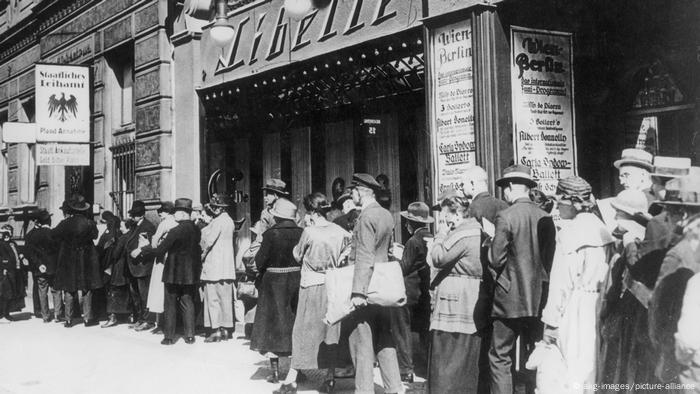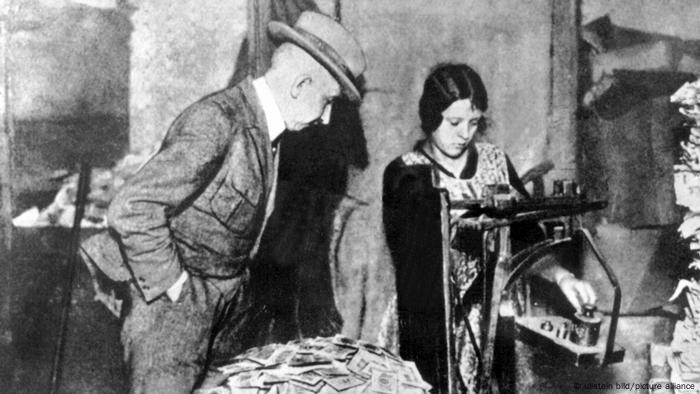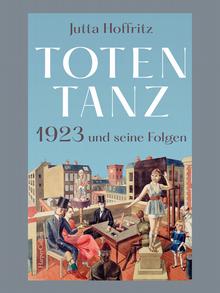The hyperinflation in the Weimar Republic had devastating consequences. The economist Jutta Hoffritz has written a book on this.

In 1924, these Berliners had to sell valuables at the lending office – inflation had swallowed up their savings
The hyperinflation in the Weimar Republic was one of the biggest economic crises in the history of Germany. It occurred in 1923, when the German economy was still suffering from the effects of World War I and was further strained by France's demands for reparations following the Treaty of Versailles – the peace agreement concluded after the war.
What is inflation?
The causes of the hyperinflation were manifold. Above all, however, the Weimar government cut itself in the foot, explains the economist and author of the book “Dance of Death – 1923 and its consequences” Jutta Hoffritz in an interview with DW.
Because when the young republic lagged behind with its reparation payments, the victorious powers occupied the Ruhr area to secure the coal mined there. The population put up passive resistance – they went on strike and stopped mining coal. The government in Berlin then started the money printing machine to continue paying the “patriotic” strikers part of their wages.
Patriotism leads to a devastating economic crisis
With this “patriotic measure”, the government has fueled the depreciation of its own currency, according to Hoffritz fetch and said 'okay, then we won't produce anything.”
When the central bank started printing money to fund the strikers, prices rose. “Where there is inflation, a loose monetary policy is not far away,” explains Jutta Hoffritz. When there is a lot of money in circulation but few raw materials, the value of money goes down. In addition, Germany had already depreciated the value of its currency during the First World War because it printed a lot of money to finance the war.

In 1923 in the Weimar Republic, money was worth so little that it was weighed instead of counted
The hyperinflation had devastating effects on the lives of people in Germany. Prices rose rapidly, and a loaf of bread soon cost hundreds of millions of Reichsmarks. In her book, Hoffritz describes how the famous German artist Käthe Kollwitz began storing potatoes even in the sublet guest room in 1923. Their value steadily increased and they could be eaten, unlike paper money. There was only a narrow path left for the subtenant to get from the door to the bed.
A currency reform brought salvation
In an attempt to get the situation under control, the Reichsbank issued more and more notes. “The Reichsdruckerei employed three times as many people in 1923 as before the war, and almost all the printers in Germany were employed by the Reichsbank to print the money” , says Hoffritz. “Almost the entire paper-processing industry was busy printing new notes, the machine was running so hot.”

Worthless notes: notes stored in the Reichsbank at the time of hyperinflation
The situation only calmed down with a new president of the Reichsbank and a currency reform: the Reichsbank stopped printing money. In addition, the so-called rye mark was introduced. An alternative currency meant to win back popular confidence, partly backed by agricultural land, Hoffritz explains. Its value was based on a given acreage and the amount of rye it produced.
According to Hoffritz, however, the success of this alternative currency was based on an illusion. No one could ever have gone to the bank with their rye mark and exchanged notes for land. But since nobody tried that either, the magic held: the currency remained stable and was accepted as a means of payment.
What about inflation today?
The situation is different today, Hoffritz told DW. There are, of course, a few analogies: “High inflation or even hyperinflation often has something to do with times of war,” she says, referring to Russia's war of aggression against Ukraine. “Fortunately we are not involved in this war ourselves, but we have collateral damage because our natural gas supply is not working.” Just like coal, a hundred years later an important resource is also scarce.
In addition, the European Central Bank has been pursuing a loose monetary policy for years. These are favorable conditions for inflation.

Jutta Hoffritz' “Dance of Death – 1923 and its consequences” was published in 2022
“But that's where the parallels end”, Hoffritz confirms. “Today we're talking about high inflation, higher than in my entire life: ten percent. That's a lot, but in 1923 we're talking about hyperinflation. That's a completely different story.”
< h2>In 1923 there was hyperinflation – and today?
Prices are currently rising by ten percent compared to the same month last year, which means that the goods were on average ten percent more expensive in November 2022 than in November 2021. With hyperinflation, prices rise by at least 50 percent every month. For bread, this would mean that its price would have increased by half in December compared to November. If it still cost three euros in November, you wouldn't be able to get it for less than 4.50 euros in December.
Hoffritz would now receive family-owned banknotes from readers of her book, notes, for example worth two million marks. “I get a lot of stories from people who, as children, found a pack of bills in the attic and felt totally rich for five minutes. Like: I found grandpa's hidden treasure.”
But that's just a misconception, Hoffritz clarifies: “Then grandma comes and says, yes, that's exactly what's left of 1923. And back then we couldn't even buy a butter sandwich for it.”